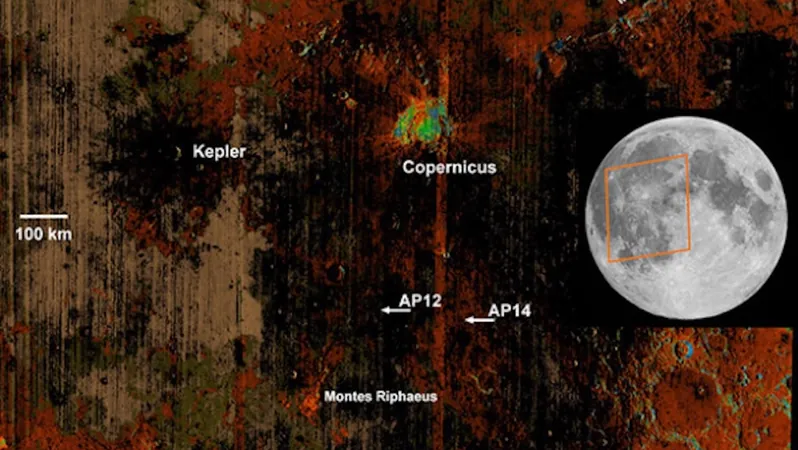
Revolutionary Tetracorder Technology Set to Transform Planetary Exploration!
2025-01-06
Author: Wei
Revolutionizing Exploration with Tetracorder Technology
In the iconic realm of Star Trek, intrepid space explorers rely on a multifunctional device known as the tricorder to tap into and analyze environmental data. However, real-world scientists have taken exploration technology light-years ahead with the advanced development of the Tetracorder, which stands to revolutionize our understanding of celestial bodies.
Advanced Capabilities
Developed by a dedicated team of researchers, the Tetracorder is capable of efficiently analyzing imaging spectrometer data—patterns of light that reveal valuable information about materials—gathered over vast expanses of land, sea, and even the cosmos. In a groundbreaking paper published in the Planetary Science Journal, scientists detail how recent advancements in Tetracorder technology allow for the rapid creation of mineral maps. These maps can significantly aid autonomous explorations, especially in challenging extraterrestrial environments.
A Leap in Capability
Roger Clark, a Senior Scientist at the Planetary Science Institute and the lead author of the study, emphasized the leap in capability compared to the laborious methods of the past. "Back in the 80s and 90s, obtaining and analyzing spectroscopic data from other planets could take weeks or even months. Now, thanks to imaging spectrometers, we can process millions of spectra every minute, necessitating a new approach to data analysis."
Color Mapping and Insights
For instance, the Tetracorder’s color mapping quickly showcases differences in water presence on the Chile-Argentina border. The technology can decipher snow patterns, revealing no detectable melting at higher elevations but significant melting at lower altitudes, providing insights into climate dynamics.
Automatic Mapping
One of the remarkable features of the Tetracorder is its ability to automatically generate comprehensive maps that designate a plethora of compounds in vivid color palettes. Researchers can specify desired compounds for various scientific inquiries, allowing for swift visualizations as fresh data streams in.
Exploring the Moon and Europa
Notably, the Tetracorder has successfully identified water and hydroxyl across the lunar surface, a monumental finding that hints at the Moon's geological history. Furthermore, the Tetracorder is poised to gather critical data regarding Europa, Jupiter's oceanic moon entombed in ice, through the Mapping Imaging Spectrometer for Europa (MISE) aboard the Europa Clipper spacecraft, which launched on October 14, 2024.
Significance of Findings
Professor Clark highlighted the significance of these findings, stating, "MISE and Tetracorder will unveil key aspects of Europa's surface composition, which is crucial for assessing its habitability. While we have detected frozen sulfuric acid that may challenge life, knowing the balance of salts in its hidden oceans could offer clues to whether life might be supported."
Guiding Future Missions
The mission data will not only inform us about Europa's environment but could also guide future lander missions to the most scientifically promising areas. Additionally, the anticipated rover equipped with Tetracorder technology could provide unparalleled insight into these locations.
Funding and Future Prospects
This groundbreaking work is made possible through funding from NASA's Environmental Monitoring of Earth’s Interior (EMIT) project, along with grants aimed at mapping extraterrestrial environments, further solidifying our understanding of potentially habitable worlds in our solar system.
Conclusion
Stay tuned as we unlock the secrets of the universe, one stunning map at a time!
 Brasil (PT)
Brasil (PT)
 Canada (EN)
Canada (EN)
 Chile (ES)
Chile (ES)
 Česko (CS)
Česko (CS)
 대한민국 (KO)
대한민국 (KO)
 España (ES)
España (ES)
 France (FR)
France (FR)
 Hong Kong (EN)
Hong Kong (EN)
 Italia (IT)
Italia (IT)
 日本 (JA)
日本 (JA)
 Magyarország (HU)
Magyarország (HU)
 Norge (NO)
Norge (NO)
 Polska (PL)
Polska (PL)
 Schweiz (DE)
Schweiz (DE)
 Singapore (EN)
Singapore (EN)
 Sverige (SV)
Sverige (SV)
 Suomi (FI)
Suomi (FI)
 Türkiye (TR)
Türkiye (TR)
 الإمارات العربية المتحدة (AR)
الإمارات العربية المتحدة (AR)